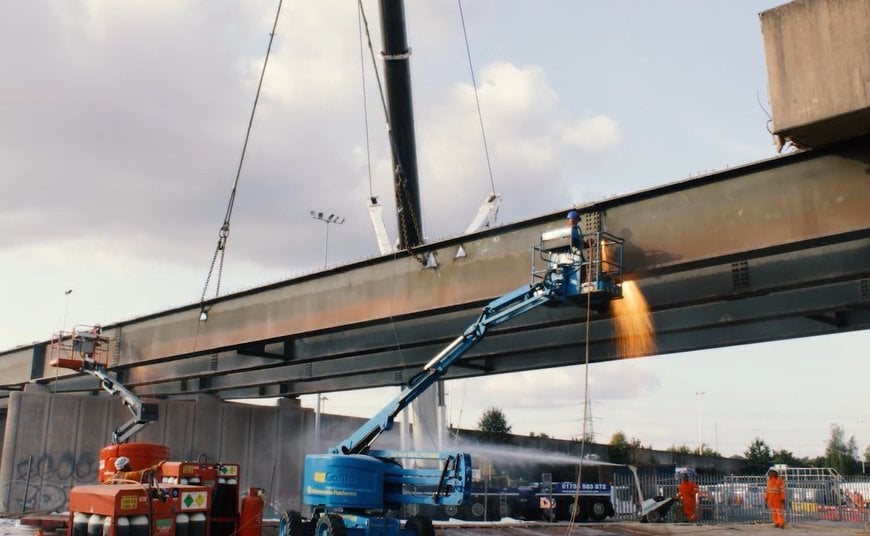Spectacular video shows HS2 contractors remove disused bridge to prepare for the new high speed rail route into Birmingham
In preparation for the construction of the northern section of HS2’s Phase One route between London and the West Midlands, main works civils contractor Balfour Beatty VINCI (BBV) have successfully demolished a disused bridge in Saltley near Birmingham.

- A disused bridge near Saltley in Birmingham has been safely demolished by HS2’s main works civils contractor Balfour Beatty VINCI (BBV)
- Over 685m3 of concrete, 165 tonnes of reinforcement and 250 tonnes of structural steel were removed by precision techniques over four weekends
The Heartlands Parkway bridge originally connected the A47 with a nearby industrial park, crossing over the busy Birmingham to Derby rail line and had been decommissioned for some time. The bridge needed to be removed because it stood in the path of the HS2 line into the new Curzon Street Station in Birmingham city centre.
Now the bridge has been demolished, it clears the way for Balfour Beatty VINCI to construct the one kilometre long Washwood Heath retained cut, and the team will start by building piling platforms for the 1,800 metres diaphragm wall, with piling works commencing later this year.
HS2’s Washwood Heath depot will also be constructed next to the railway in this area, which will be HS2’s central control centre and maintenance depot, including a 40,000m2 rolling stock maintenance building, carriage wash, automatic vehicle inspection building and 14 sidings where trains can be stored overnight.
The construction of the Washwood Heath depot will transform the 40 hectares brown field site into the nerve centre of the HS2 network, with the added benefit of offering up to 500 long-term jobs. Three bidders have recently been invited to tender for the contract to build the depot and control centre.
Jean-Baptiste Tessier, Construction Director at Balfour Beatty VINCI said:
“The demolition of the A47 bridge signifies yet another milestone in the delivery of the northern section of the UK’s high-speed railway, paving the way for the new HS2 route into Curzon Street Station.
“Over the course of four weekends, our expert team safely and successfully removed the structure, working alongside Network Rail and Birmingham City Council to reduce disruption to the travelling public, wherever possible.”
Patrick Cawley, Director of On Network Works for HS2 Ltd and Network Rail, said:
“We kept passengers on the move over the affected weekends, following close collaboration with our train company partners and Balfour Beatty VINCI. The A47 Heartlands Bridge demolition was a highly complex project affecting major pieces of rail infrastructure: although the bridge had been out of use for some time, it crossed the busy Birmingham to Derby line. Our Asset Protection Engineers worked with HS2 Engineers to allow them to safely complete the work while causing the least amount of disruption possible."
Contractors working with BBV to deliver the work included John F Hunt (Regeneration), a business with 14 regional offices nationwide including a Birmingham depot, who were responsible for the demolition of the bridge. Their subcontractors were Pod-Trak who were responsible for the protection of the rail track, and Andun Engineering Consultants who managed the temporary works design required for the demolition.
Tony Fenwick, Operations Director for John F Hunt Regeneration (Industrial) said:
“The location of the bridge was particularly unique as it crossed over seven freight and commuter rail lines and was originally constructed using over 685m3 of concrete, 165 tonnes of reinforcement and 250 tonnes of structural steel.
“Fifty people were involved in the precision operation each weekend, with engineers using specialist equipment, including excavators fitted with concrete pulverisers and breakers to demolish the bridge piece by piece, allowing the structural steel to be lifted away by crane. It was a great experience to help deliver such a crucial part of the HS2 project.”
Once operational, Phase One and Phase 2a will require a fleet of at least 54 trains which will be based at Washwood Heath. The 200 metres long units are designed to adapt to daily passenger changes by “doubling up” to create 400 metres long trains serving destinations beyond the HS2 network including Liverpool, Preston, Carlisle and Glasgow – via a connection to the existing West Coast Main Line at Crewe.
www.hs2.com

